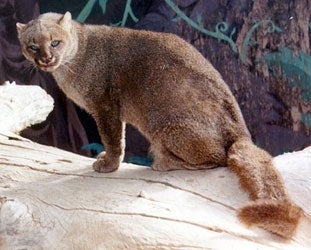By Mitchell Marks, Wildlife Biologist, Retired
Year after year, reports of large black cats come in from across Alabama. The reports vary from mere sightings, to pets disappearing and livestock being killed. Reports have been investigated, evidence photographed and samples taken to try to prove or disprove that these animals exist in Alabama. However, they have proven to be so elusive, that even the best trappers have not been able to catch one. A look at black cats known to exist in other parts of the world may lead us to find out which, if any, black cats are to be found in Alabama.
In the eastern hemisphere, most specifically Asia and Africa, the leopard is the only wild cat that has a black or melanistic phase. In its melanistic phase, the leopard is often referred to as a black panther. Leopards once ranged from Europe throughout Asia and Africa. Its range is now limited to parts of Africa and southeastern Asia. Habitat loss due to human population expansion, the value of its fur in the market place, potential livestock losses and a lack of human understanding of its role in the ecosystem are reasons for its limited range.
In the western hemisphere, which consists of North and South America, there are two cats that have a black or melanistic phase. The jaguar is the largest of these, and probably the most well known. Its former range included southwestern Louisiana and coastal Texas, Mexico, Central America and South America. Its current range is mostly restricted to Central and South America. The jaguar is a stocky, powerful cat that normally weighs between 100 and 150 pounds, although some males have been known to reach 9 feet in length and weigh 350 pounds.
The jaguar’s smaller cousin, the jaguarundi, was found throughout the jaguar’s former range and may have ranged as far east, along coastal areas, as the Florida Panhandle. Its current range is similar to the jaguar, but may also be found as far north as southern Texas. The jaguarundi only reaches about 22 pounds in weight with a total length of 3½ to 4 feet and stands only about 11 inches at the shoulder. The jaguarundi coat comes in several different colors, with the dark fur most often occurring in animals from jungle regions and animals with lighter colored fur being found in drier, more arid regions. Like the leopard, human population expansion, the value of its fur in the market place, potential livestock loses and a lack of human understanding of these animal’s roles in the ecosystem have limited its range.
Alabama has two native cats. The first and largest is the mountain lion, also called a cougar, catamount, painter, puma or panther. Cougars are tawny brown to grayish in color, weighing from 75 to 120 pounds, and can reach a length of about 6½ feet, nose to tail. The population, if it still exists, is scarce within the state. The bobcat is the other native cat found in Alabama. It is a much smaller cat with a short tail and spotted fur. Adult body weights normally range from 25 to 30 pounds. Despite its small size, it is a formidable predator. However, neither of these cats has a black or melanistic color phase.
So, with no native black cats in Alabama, what are people reporting seeing? Almost all of the reports are proven to be cases of mistaken identity, or possibly animals that have been released or escaped from captivity. Some field investigations have found distinct tracks and/or bite marks. Further investigations have revealed the tracks and bite marks match those of canines, not felines, so the culprits are many times coyotes or dogs.
It is suspected that some large cats may have been released from captivity, which could account for some sightings. Most people aren’t prepared to take care of a cat that weighs over 100 pounds. When overwhelmed by their size, care requirements or the chance of being caught by the U.S. Department Agriculture, the agency responsible for governing exotic animals, some people may begin to look for ways to get rid of them. So, the animal is released into the wild. Unexplained disappearances of large cats have even happened with individuals permitted to posses these animals. How much this actually happens, we may never know. It is a potential reason of why some people have reported seeing large black cats or “black panthers” in Alabama.
After reviewing trapping and hunting records back to the 1600s and reports of vehicle collisions with animals from around the state, we can say with relative assurance that there are no native black cats in Alabama. However, if you do think that you see such a creature, try to preserve the tracks by placing a bucket over them and take photographs. You will then want to contact a representative of the Division of Wildlife and Freshwater Fisheries for further investigation.






